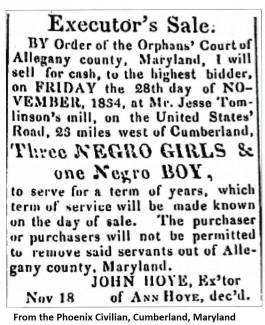Collection Name
About
Executor’s Sale - Tomlinson’s Mill, Grantsville
The following information is in large part taken from and courtesy of an article appearing in the 2018, Volume LVIII Issue of The Casselman Chronicle entitled, “African-Americans’ Lives in the Grantsville District” by Beth Page:
The Executor’s Sale noted above was held at Jesse Tomlinson’s mill along the “United States” road, just east of Grantsville and 23 miles west of Cumberland. Garrett County was not formally established until 1872 and at the time of this sale on November 28, 1834 the Grantsville community was still part of Allegany County. It should also be noted Jesse Tomlinson’s Mill from the 1834 sale, noted above, was replaced by the current Stanton’s Mill (near Penn Alps) which had been constructed in about 1859.
The sale consisted of “Three NEGRO GIRLS & one Negro BOY.” The “servants” were to serve a term of ten years and whoever purchased them could not relocate them out of the county. The three girls and one boy were apparently the property of Ann Hoye who lived in the Grantsville area, and the sale was conducted by her brother, John Hoye.
The earliest record of the sale and purchase of slaves in the Casselman Valley dates back to 1795. Among the more notable local slave-owners identified in the 1800 Census records were Jesse Tomlinson (1753-1840) who in 1818 constructed the nearby Tomlinson’s Inn and Daniel Grant (1734-1816) for whom the Town of Grantsville is named. By 1820 the Grantsville district was listed as having forty slaves, twenty-two free “colored” and 305 white people. One-fifth of the total population was identified as being of African-American descent. Slavery in Allegany County, which again at this time included present-day Garrett County, reached its peak in 1830 with 818 slaves (and 222 “Free Blacks”). Slavery would then begin its steady decline leading up to the Civil War. There were no slaves identified in the Grantsville district by 1860, with most of the county’s 658 (other sources say 666) slaves living in the Cumberland area.
Here is a little background on John Hoye, the executor referenced in the sale notice, from “Feldstein’s Gone But Not Forgotten, A Biographical Tribute to Historic Allegany County Figures and Notable Personages from the Past, Volume II,” 1989:
John Hoye (1774-1849) was known as “the land king of Allegany County.” He lived in the Hoye Mansion adjoining Court House Square on Washington Street in Cumberland. Upon Cumberland’s formal 1815 incorporation the “free white male citizens” of the city, who were also required to be property owners, elected Hoye as one of the town’s five commissioners, and the 1820 census shows the Hoye household consisting of four family members and ten slaves. Hoye owned thousands of acres along the planned routes of the Baltimore & Ohio Railroad as well as what is now Route 50 through Garrett County. The will of his wife, Mary, stated that a portion of her estate go toward “Christianizing the African Race”. She had also donated the site for the Mary Hoye School, a black public school on Independence Street in Cumberland.
-------
Note: “Executor’s Sale” notice of November 18, 1834 from the Phoenix Civilian of Cumberland, Maryland. Reproduced here courtesy of the Casselman Chronicle and Janet Bender and from an article appearing in the 2018, Volume LVIII Issue of The Casselman Chronicle entitled, “African-Americans’ Lives in the Grantsville District” by Beth Page.
I would also like to thank Titus Peachey for bringing these Casselman Chronicle articles to my attention.
